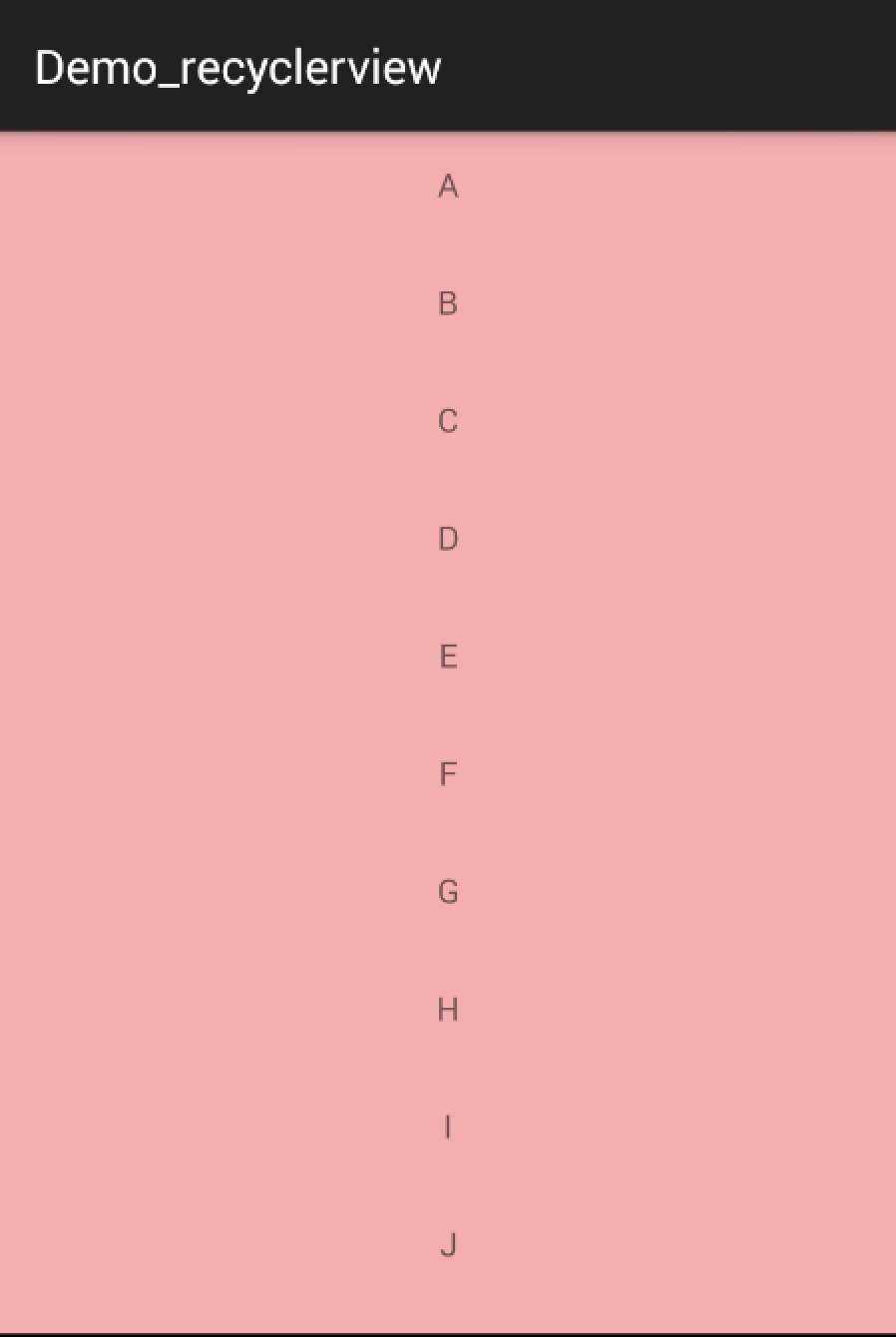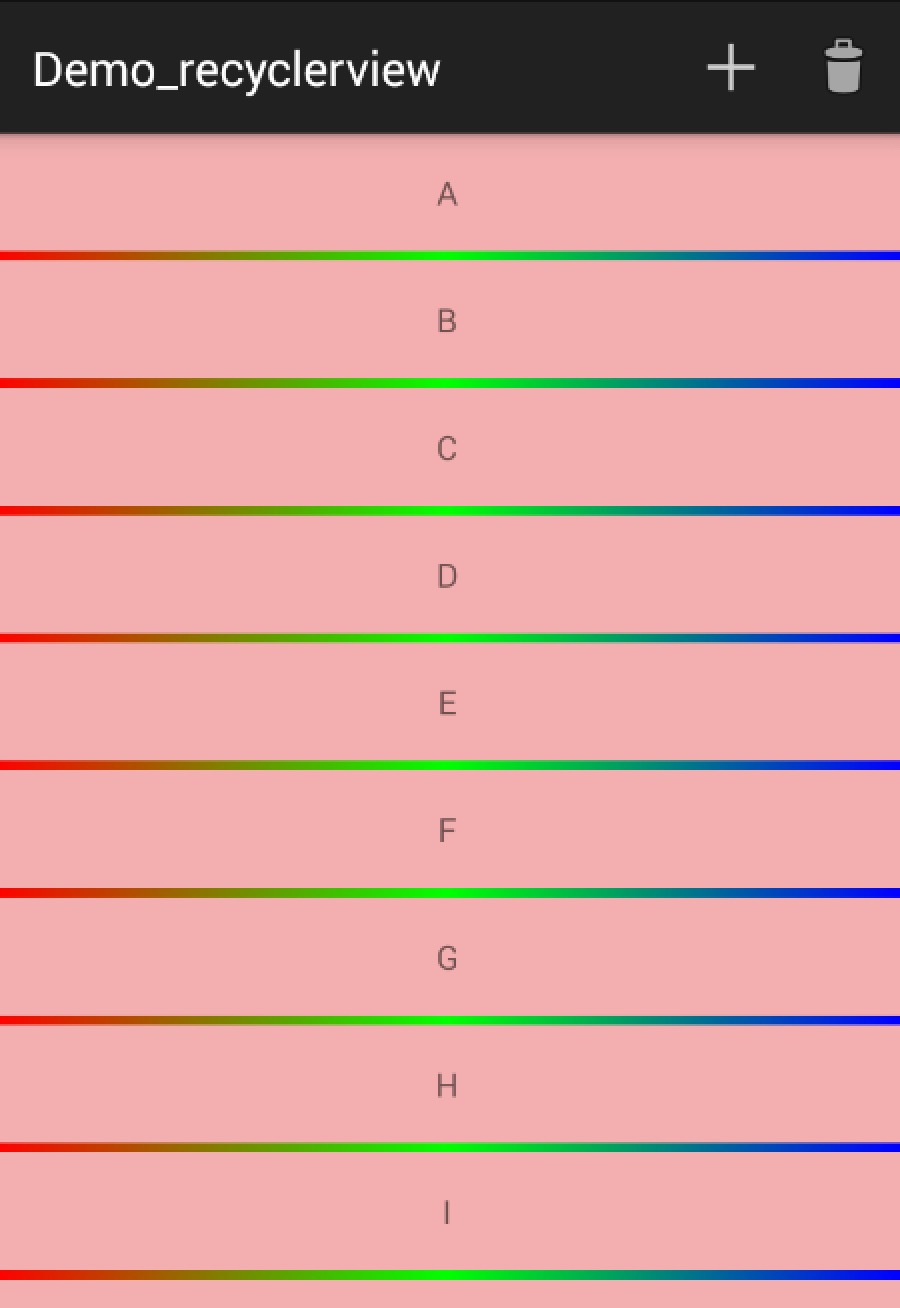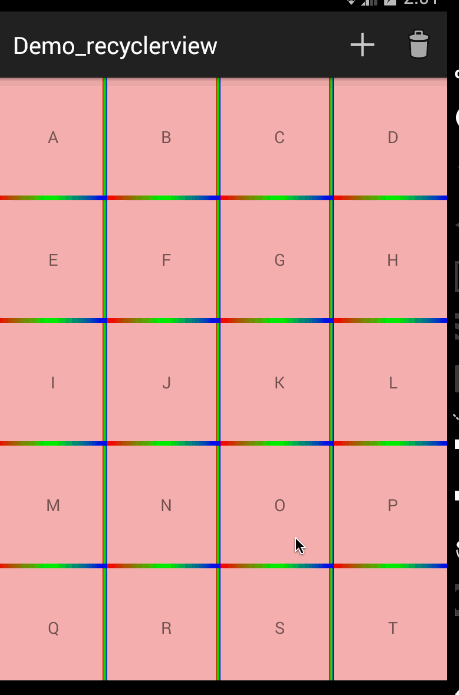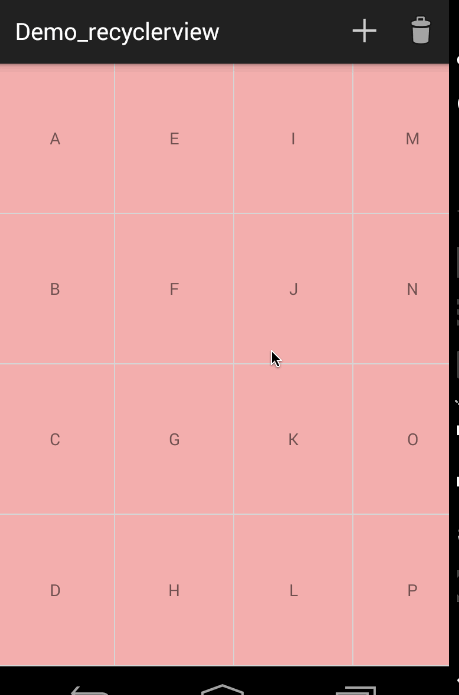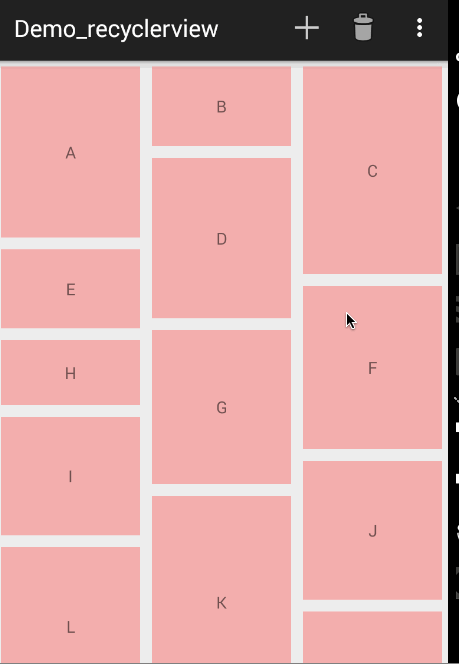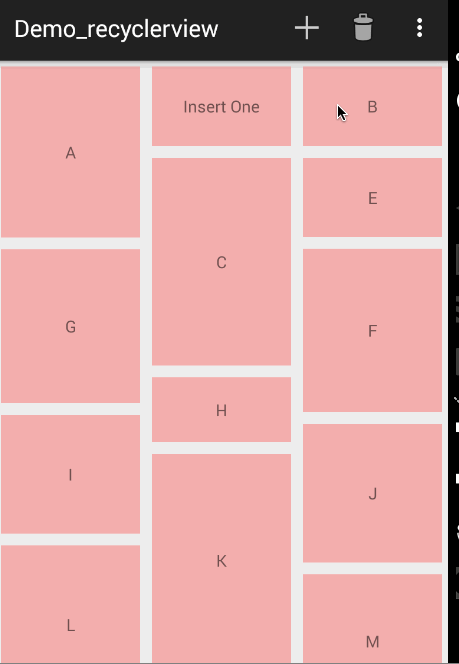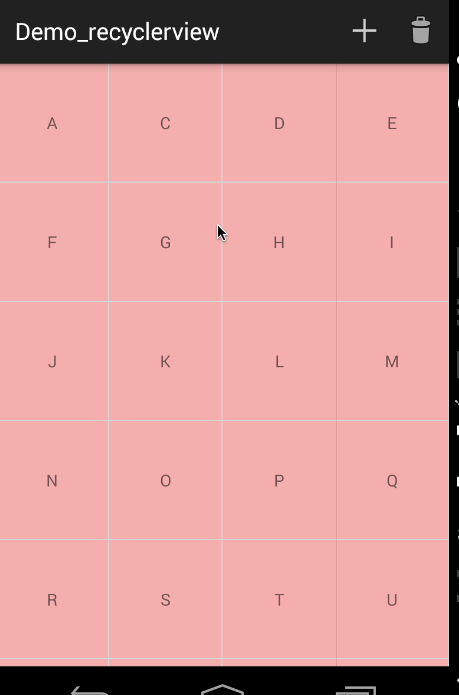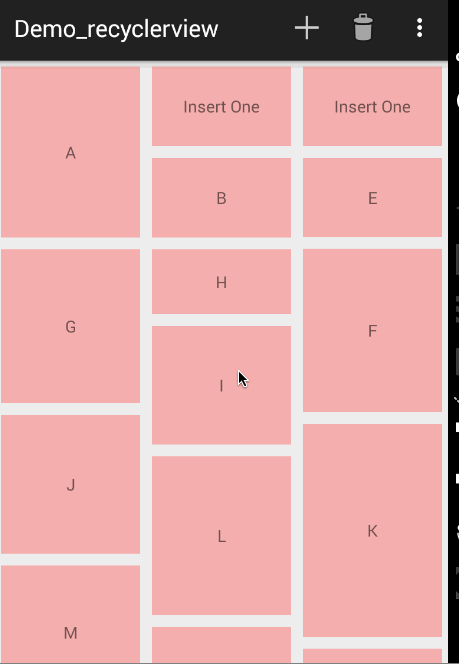转载请标明出处:
http://blog.csdn.net/lmj623565791/article/details/45059587;
本文出自:【张鸿洋的博客】
概述
RecyclerView出现已经有一段时间了,相信大家肯定不陌生了,大家可以通过导入support-v7对其进行使用。
据官方的介绍,该控件用于在有限的窗口中展示大量数据集,其实这样功能的控件我们并不陌生,例如:ListView、GridView。
那么有了ListView、GridView为什么还需要RecyclerView这样的控件呢?整体上看RecyclerView架构,提供了一种插拔式的体验,高度的解耦,异常的灵活,通过设置它提供的不同LayoutManager,ItemDecoration , ItemAnimator实现令人瞠目的效果。
- 你想要控制其显示的方式,请通过布局管理器LayoutManager
- 你想要控制Item间的间隔(可绘制),请通过ItemDecoration
- 你想要控制Item增删的动画,请通过ItemAnimator
- 你想要控制点击、长按事件,请自己写(擦,这点尼玛。)
基本使用
鉴于我们对于ListView的使用特别的熟悉,对比下RecyclerView的使用代码:
- mRecyclerView = findView(R.id.id_recyclerview);
- //设置布局管理器
- mRecyclerView.setLayoutManager(layout);
- //设置adapter
- mRecyclerView.setAdapter(adapter)
- //设置Item增加、移除动画
- mRecyclerView.setItemAnimator(new DefaultItemAnimator());
- //添加分割线
- mRecyclerView.addItemDecoration(new DividerItemDecoration(
- getActivity(), DividerItemDecoration.HORIZONTAL_LIST));
- 1
- 2
- 3
- 4
- 5
- 6
- 7
- 8
- 9
- 10
ok,相比较于ListView的代码,ListView可能只需要去设置一个adapter就能正常使用了。而RecyclerView基本需要上面一系列的步骤,那么为什么会添加这么多的步骤呢?
那么就必须解释下RecyclerView的这个名字了,从它类名上看,RecyclerView代表的意义是,我只管Recycler View,也就是说RecyclerView只管回收与复用View,其他的你可以自己去设置。可以看出其高度的解耦,给予你充分的定制自由(所以你才可以轻松的通过这个控件实现ListView,GirdView,瀑布流等效果)。
Just like ListView
- Activity
- package com.zhy.sample.demo_recyclerview;
-
- import java.util.ArrayList;
- import java.util.List;
-
- import android.os.Bundle;
- import android.support.v7.app.ActionBarActivity;
- import android.support.v7.widget.LinearLayoutManager;
- import android.support.v7.widget.RecyclerView;
- import android.support.v7.widget.RecyclerView.ViewHolder;
- import android.view.LayoutInflater;
- import android.view.View;
- import android.view.ViewGroup;
- import android.widget.TextView;
-
- public class HomeActivity extends ActionBarActivity
- {
-
- private RecyclerView mRecyclerView;
- private List<String> mDatas;
- private HomeAdapter mAdapter;
-
- @Override
- protected void onCreate(Bundle savedInstanceState)
- {
- super.onCreate(savedInstanceState);
- setContentView(R.layout.activity_single_recyclerview);
-
- initData();
- mRecyclerView = (RecyclerView) findViewById(R.id.id_recyclerview);
- mRecyclerView.setLayoutManager(new LinearLayoutManager(this));
- mRecyclerView.setAdapter(mAdapter = new HomeAdapter());
-
- }
-
- protected void initData()
- {
- mDatas = new ArrayList<String>();
- for (int i = 'A'; i < 'z'; i++)
- {
- mDatas.add("" + (char) i);
- }
- }
-
- class HomeAdapter extends RecyclerView.Adapter<HomeAdapter.MyViewHolder>
- {
-
- @Override
- public MyViewHolder onCreateViewHolder(ViewGroup parent, int viewType)
- {
- MyViewHolder holder = new MyViewHolder(LayoutInflater.from(
- HomeActivity.this).inflate(R.layout.item_home, parent,
- false));
- return holder;
- }
-
- @Override
- public void onBindViewHolder(MyViewHolder holder, int position)
- {
- holder.tv.setText(mDatas.get(position));
- }
-
- @Override
- public int getItemCount()
- {
- return mDatas.size();
- }
-
- class MyViewHolder extends ViewHolder
- {
-
- TextView tv;
-
- public MyViewHolder(View view)
- {
- super(view);
- tv = (TextView) view.findViewById(R.id.id_num);
- }
- }
- }
-
- }
- 1
- 2
- 3
- 4
- 5
- 6
- 7
- 8
- 9
- 10
- 11
- 12
- 13
- 14
- 15
- 16
- 17
- 18
- 19
- 20
- 21
- 22
- 23
- 24
- 25
- 26
- 27
- 28
- 29
- 30
- 31
- 32
- 33
- 34
- 35
- 36
- 37
- 38
- 39
- 40
- 41
- 42
- 43
- 44
- 45
- 46
- 47
- 48
- 49
- 50
- 51
- 52
- 53
- 54
- 55
- 56
- 57
- 58
- 59
- 60
- 61
- 62
- 63
- 64
- 65
- 66
- 67
- 68
- 69
- 70
- 71
- 72
- 73
- 74
- 75
- 76
- 77
- 78
- 79
- 80
- 81
- 82
- Activity的布局文件
- <RelativeLayout xmlns:android="http://schemas.android.com/apk/res/android"
- xmlns:tools="http://schemas.android.com/tools"
- android:layout_width="match_parent"
- android:layout_height="match_parent" >
-
- <android.support.v7.widget.RecyclerView
- android:id="@+id/id_recyclerview"
- android:divider="#ffff0000"
- android:dividerHeight="10dp"
- android:layout_width="match_parent"
- android:layout_height="match_parent" />
-
- </RelativeLayout>
- 1
- 2
- 3
- 4
- 5
- 6
- 7
- 8
- 9
- 10
- 11
- 12
- 13
- Item的布局文件
- <?xml version="1.0" encoding="utf-8"?>
- <FrameLayout xmlns:android="http://schemas.android.com/apk/res/android"
- android:layout_width="match_parent"
- android:background="#44ff0000"
- android:layout_height="wrap_content" >
-
- <TextView
- android:id="@+id/id_num"
- android:layout_width="match_parent"
- android:layout_height="50dp"
- android:gravity="center"
- android:text="1" />
- </FrameLayout>
- 1
- 2
- 3
- 4
- 5
- 6
- 7
- 8
- 9
- 10
- 11
- 12
- 13
这么看起来用法与ListView的代码基本一致哈~~
看下效果图:
看起来好丑,Item间应该有个分割线,当你去找时,你会发现RecyclerView并没有支持divider这样的属性。那么怎么办,你可以给Item的布局去设置margin,当然了这种方式不够优雅,我们文章开始说了,我们可以自由的去定制它,当然我们的分割线也是可以定制的。
ItemDecoration
我们可以通过该方法添加分割线: mRecyclerView.addItemDecoration()
该方法的参数为RecyclerView.ItemDecoration,该类为抽象类,官方目前并没有提供默认的实现类(我觉得最好能提供几个)。
该类的源码:
- public static abstract class ItemDecoration {
-
- public void onDraw(Canvas c, RecyclerView parent, State state) {
- onDraw(c, parent);
- }
-
-
- public void onDrawOver(Canvas c, RecyclerView parent, State state) {
- onDrawOver(c, parent);
- }
-
- public void getItemOffsets(Rect outRect, View view, RecyclerView parent, State state) {
- getItemOffsets(outRect, ((LayoutParams) view.getLayoutParams()).getViewLayoutPosition(),
- parent);
- }
-
- @Deprecated
- public void getItemOffsets(Rect outRect, int itemPosition, RecyclerView parent) {
- outRect.set(0, 0, 0, 0);
- }
- 1
- 2
- 3
- 4
- 5
- 6
- 7
- 8
- 9
- 10
- 11
- 12
- 13
- 14
- 15
- 16
- 17
- 18
- 19
- 20
- 21
当我们调用mRecyclerView.addItemDecoration()方法添加decoration的时候,RecyclerView在绘制的时候,去会绘制decorator,即调用该类的onDraw和onDrawOver方法,
- onDraw方法先于drawChildren
- onDrawOver在drawChildren之后,一般我们选择复写其中一个即可。
- getItemOffsets 可以通过outRect.set()为每个Item设置一定的偏移量,主要用于绘制Decorator。
接下来我们看一个RecyclerView.ItemDecoration的实现类,该类很好的实现了RecyclerView添加分割线(当使用LayoutManager为LinearLayoutManager时)。
该类参考自:DividerItemDecoration
-
- package com.zhy.sample.demo_recyclerview;
-
- /*
- * Copyright (C) 2014 The Android Open Source Project
- *
- * Licensed under the Apache License, Version 2.0 (the "License");
- * limitations under the License.
- */
-
- import android.content.Context;
- import android.content.res.TypedArray;
- import android.graphics.Canvas;
- import android.graphics.Rect;
- import android.graphics.drawable.Drawable;
- import android.support.v7.widget.LinearLayoutManager;
- import android.support.v7.widget.RecyclerView;
- import android.support.v7.widget.RecyclerView.State;
- import android.util.Log;
- import android.view.View;
-
-
- /**
- * This class is from the v7 samples of the Android SDK. It's not by me!
- * <p/>
- * See the license above for details.
- */
- public class DividerItemDecoration extends RecyclerView.ItemDecoration {
-
- private static final int[] ATTRS = new int[]{
- android.R.attr.listDivider
- };
-
- public static final int HORIZONTAL_LIST = LinearLayoutManager.HORIZONTAL;
-
- public static final int VERTICAL_LIST = LinearLayoutManager.VERTICAL;
-
- private Drawable mDivider;
-
- private int mOrientation;
-
- public DividerItemDecoration(Context context, int orientation) {
- final TypedArray a = context.obtainStyledAttributes(ATTRS);
- mDivider = a.getDrawable(0);
- a.recycle();
- setOrientation(orientation);
- }
-
- public void setOrientation(int orientation) {
- if (orientation != HORIZONTAL_LIST && orientation != VERTICAL_LIST) {
- throw new IllegalArgumentException("invalid orientation");
- }
- mOrientation = orientation;
- }
-
- @Override
- public void onDraw(Canvas c, RecyclerView parent) {
- Log.v("recyclerview - itemdecoration", "onDraw()");
-
- if (mOrientation == VERTICAL_LIST) {
- drawVertical(c, parent);
- } else {
- drawHorizontal(c, parent);
- }
-
- }
-
-
- public void drawVertical(Canvas c, RecyclerView parent) {
- final int left = parent.getPaddingLeft();
- final int right = parent.getWidth() - parent.getPaddingRight();
-
- final int childCount = parent.getChildCount();
- for (int i = 0; i < childCount; i++) {
- final View child = parent.getChildAt(i);
- android.support.v7.widget.RecyclerView v = new android.support.v7.widget.RecyclerView(parent.getContext());
- final RecyclerView.LayoutParams params = (RecyclerView.LayoutParams) child
- .getLayoutParams();
- final int top = child.getBottom() + params.bottomMargin;
- final int bottom = top + mDivider.getIntrinsicHeight();
- mDivider.setBounds(left, top, right, bottom);
- mDivider.draw(c);
- }
- }
-
- public void drawHorizontal(Canvas c, RecyclerView parent) {
- final int top = parent.getPaddingTop();
- final int bottom = parent.getHeight() - parent.getPaddingBottom();
-
- final int childCount = parent.getChildCount();
- for (int i = 0; i < childCount; i++) {
- final View child = parent.getChildAt(i);
- final RecyclerView.LayoutParams params = (RecyclerView.LayoutParams) child
- .getLayoutParams();
- final int left = child.getRight() + params.rightMargin;
- final int right = left + mDivider.getIntrinsicHeight();
- mDivider.setBounds(left, top, right, bottom);
- mDivider.draw(c);
- }
- }
-
- @Override
- public void getItemOffsets(Rect outRect, int itemPosition, RecyclerView parent) {
- if (mOrientation == VERTICAL_LIST) {
- outRect.set(0, 0, 0, mDivider.getIntrinsicHeight());
- } else {
- outRect.set(0, 0, mDivider.getIntrinsicWidth(), 0);
- }
- }
- }
- 1
- 2
- 3
- 4
- 5
- 6
- 7
- 8
- 9
- 10
- 11
- 12
- 13
- 14
- 15
- 16
- 17
- 18
- 19
- 20
- 21
- 22
- 23
- 24
- 25
- 26
- 27
- 28
- 29
- 30
- 31
- 32
- 33
- 34
- 35
- 36
- 37
- 38
- 39
- 40
- 41
- 42
- 43
- 44
- 45
- 46
- 47
- 48
- 49
- 50
- 51
- 52
- 53
- 54
- 55
- 56
- 57
- 58
- 59
- 60
- 61
- 62
- 63
- 64
- 65
- 66
- 67
- 68
- 69
- 70
- 71
- 72
- 73
- 74
- 75
- 76
- 77
- 78
- 79
- 80
- 81
- 82
- 83
- 84
- 85
- 86
- 87
- 88
- 89
- 90
- 91
- 92
- 93
- 94
- 95
- 96
- 97
- 98
- 99
- 100
- 101
- 102
- 103
- 104
- 105
- 106
- 107
- 108
- 109
- 110
该实现类可以看到通过读取系统主题中的 android.R.attr.listDivider作为Item间的分割线,并且支持横向和纵向。如果你不清楚它是怎么做到的读取系统的属性用于自身,请参考我的另一篇博文:Android 深入理解Android中的自定义属性
获取到listDivider以后,该属性的值是个Drawable,在getItemOffsets中,outRect去设置了绘制的范围。onDraw中实现了真正的绘制。
我们在原来的代码中添加一句:
- mRecyclerView.addItemDecoration(new DividerItemDecoration(this,
- DividerItemDecoration.VERTICAL_LIST));
- 1
- 2
ok,现在再运行,就可以看到分割线的效果了。
该分割线是系统默认的,你可以在theme.xml中找到该属性的使用情况。那么,使用系统的listDivider有什么好处呢?就是方便我们去随意的改变,该属性我们可以直接声明在:
- <!-- Application theme. -->
- <style name="AppTheme" parent="AppBaseTheme">
- <item name="android:listDivider">@drawable/divider_bg</item>
- </style>
- 1
- 2
- 3
- 4
然后自己写个drawable即可,下面我们换一种分隔符:
- <?xml version="1.0" encoding="utf-8"?>
- <shape xmlns:android="http://schemas.android.com/apk/res/android"
- android:shape="rectangle" >
-
- <gradient
- android:centerColor="#ff00ff00"
- android:endColor="#ff0000ff"
- android:startColor="#ffff0000"
- android:type="linear" />
- <size android:height="4dp"/>
-
- </shape>
- 1
- 2
- 3
- 4
- 5
- 6
- 7
- 8
- 9
- 10
- 11
- 12
现在的样子是:
当然了,你可以根据自己的需求,去随意的绘制,反正是画出来的,随便玩~~
ok,看到这,你可能觉得,这玩意真尼玛麻烦,完全不能比拟的心爱的ListView。那么继续看。
LayoutManager
好了,上面实现了类似ListView样子的Demo,通过使用其默认的LinearLayoutManager。
RecyclerView.LayoutManager吧,这是一个抽象类,好在系统提供了3个实现类:
- LinearLayoutManager 现行管理器,支持横向、纵向。
- GridLayoutManager 网格布局管理器
- StaggeredGridLayoutManager 瀑布就式布局管理器
上面我们已经初步体验了下LinearLayoutManager,接下来看GridLayoutManager。
- GridLayoutManager
我们尝试去实现类似GridView,秒秒钟的事情:
- //mRecyclerView.setLayoutManager(new LinearLayoutManager(this));
- mRecyclerView.setLayoutManager(new GridLayoutManager(this,4));
- 1
- 2
只需要修改LayoutManager即可,还是很nice的。
当然了,改为GridLayoutManager以后,对于分割线,前面的DividerItemDecoration就不适用了,主要是因为它在绘制的时候,比如水平线,针对每个child的取值为:
- final int left = parent.getPaddingLeft();
- final int right = parent.getWidth() - parent.getPaddingRight();
- 1
- 2
因为每个Item一行,这样是没问题的。而GridLayoutManager时,一行有多个childItem,这样就多次绘制了,并且GridLayoutManager时,Item如果为最后一列(则右边无间隔线)或者为最后一行(底部无分割线)。
针对上述,我们编写了DividerGridItemDecoration。
- package com.zhy.sample.demo_recyclerview;
-
- import android.content.Context;
- import android.content.res.TypedArray;
- import android.graphics.Canvas;
- import android.graphics.Rect;
- import android.graphics.drawable.Drawable;
- import android.support.v7.widget.GridLayoutManager;
- import android.support.v7.widget.RecyclerView;
- import android.support.v7.widget.RecyclerView.LayoutManager;
- import android.support.v7.widget.RecyclerView.State;
- import android.support.v7.widget.StaggeredGridLayoutManager;
- import android.view.View;
-
- /**
- *
- * @author zhy
- *
- */
- public class DividerGridItemDecoration extends RecyclerView.ItemDecoration
- {
-
- private static final int[] ATTRS = new int[] { android.R.attr.listDivider };
- private Drawable mDivider;
-
- public DividerGridItemDecoration(Context context)
- {
- final TypedArray a = context.obtainStyledAttributes(ATTRS);
- mDivider = a.getDrawable(0);
- a.recycle();
- }
-
- @Override
- public void onDraw(Canvas c, RecyclerView parent, State state)
- {
-
- drawHorizontal(c, parent);
- drawVertical(c, parent);
-
- }
-
- private int getSpanCount(RecyclerView parent)
- {
- // 列数
- int spanCount = -1;
- LayoutManager layoutManager = parent.getLayoutManager();
- if (layoutManager instanceof GridLayoutManager)
- {
-
- spanCount = ((GridLayoutManager) layoutManager).getSpanCount();
- } else if (layoutManager instanceof StaggeredGridLayoutManager)
- {
- spanCount = ((StaggeredGridLayoutManager) layoutManager)
- .getSpanCount();
- }
- return spanCount;
- }
-
- public void drawHorizontal(Canvas c, RecyclerView parent)
- {
- int childCount = parent.getChildCount();
- for (int i = 0; i < childCount; i++)
- {
- final View child = parent.getChildAt(i);
- final RecyclerView.LayoutParams params = (RecyclerView.LayoutParams) child
- .getLayoutParams();
- final int left = child.getLeft() - params.leftMargin;
- final int right = child.getRight() + params.rightMargin
- + mDivider.getIntrinsicWidth();
- final int top = child.getBottom() + params.bottomMargin;
- final int bottom = top + mDivider.getIntrinsicHeight();
- mDivider.setBounds(left, top, right, bottom);
- mDivider.draw(c);
- }
- }
-
- public void drawVertical(Canvas c, RecyclerView parent)
- {
- final int childCount = parent.getChildCount();
- for (int i = 0; i < childCount; i++)
- {
- final View child = parent.getChildAt(i);
-
- final RecyclerView.LayoutParams params = (RecyclerView.LayoutParams) child
- .getLayoutParams();
- final int top = child.getTop() - params.topMargin;
- final int bottom = child.getBottom() + params.bottomMargin;
- final int left = child.getRight() + params.rightMargin;
- final int right = left + mDivider.getIntrinsicWidth();
-
- mDivider.setBounds(left, top, right, bottom);
- mDivider.draw(c);
- }
- }
-
- private boolean isLastColum(RecyclerView parent, int pos, int spanCount,
- int childCount)
- {
- LayoutManager layoutManager = parent.getLayoutManager();
- if (layoutManager instanceof GridLayoutManager)
- {
- if ((pos + 1) % spanCount == 0)// 如果是最后一列,则不需要绘制右边
- {
- return true;
- }
- } else if (layoutManager instanceof StaggeredGridLayoutManager)
- {
- int orientation = ((StaggeredGridLayoutManager) layoutManager)
- .getOrientation();
- if (orientation == StaggeredGridLayoutManager.VERTICAL)
- {
- if ((pos + 1) % spanCount == 0)// 如果是最后一列,则不需要绘制右边
- {
- return true;
- }
- } else
- {
- childCount = childCount - childCount % spanCount;
- if (pos >= childCount)// 如果是最后一列,则不需要绘制右边
- return true;
- }
- }
- return false;
- }
-
- private boolean isLastRaw(RecyclerView parent, int pos, int spanCount,
- int childCount)
- {
- LayoutManager layoutManager = parent.getLayoutManager();
- if (layoutManager instanceof GridLayoutManager)
- {
- childCount = childCount - childCount % spanCount;
- if (pos >= childCount)// 如果是最后一行,则不需要绘制底部
- return true;
- } else if (layoutManager instanceof StaggeredGridLayoutManager)
- {
- int orientation = ((StaggeredGridLayoutManager) layoutManager)
- .getOrientation();
- // StaggeredGridLayoutManager 且纵向滚动
- if (orientation == StaggeredGridLayoutManager.VERTICAL)
- {
- childCount = childCount - childCount % spanCount;
- // 如果是最后一行,则不需要绘制底部
- if (pos >= childCount)
- return true;
- } else
- // StaggeredGridLayoutManager 且横向滚动
- {
- // 如果是最后一行,则不需要绘制底部
- if ((pos + 1) % spanCount == 0)
- {
- return true;
- }
- }
- }
- return false;
- }
-
- @Override
- public void getItemOffsets(Rect outRect, int itemPosition,
- RecyclerView parent)
- {
- int spanCount = getSpanCount(parent);
- int childCount = parent.getAdapter().getItemCount();
- if (isLastRaw(parent, itemPosition, spanCount, childCount))// 如果是最后一行,则不需要绘制底部
- {
- outRect.set(0, 0, mDivider.getIntrinsicWidth(), 0);
- } else if (isLastColum(parent, itemPosition, spanCount, childCount))// 如果是最后一列,则不需要绘制右边
- {
- outRect.set(0, 0, 0, mDivider.getIntrinsicHeight());
- } else
- {
- outRect.set(0, 0, mDivider.getIntrinsicWidth(),
- mDivider.getIntrinsicHeight());
- }
- }
- }
- 1
- 2
- 3
- 4
- 5
- 6
- 7
- 8
- 9
- 10
- 11
- 12
- 13
- 14
- 15
- 16
- 17
- 18
- 19
- 20
- 21
- 22
- 23
- 24
- 25
- 26
- 27
- 28
- 29
- 30
- 31
- 32
- 33
- 34
- 35
- 36
- 37
- 38
- 39
- 40
- 41
- 42
- 43
- 44
- 45
- 46
- 47
- 48
- 49
- 50
- 51
- 52
- 53
- 54
- 55
- 56
- 57
- 58
- 59
- 60
- 61
- 62
- 63
- 64
- 65
- 66
- 67
- 68
- 69
- 70
- 71
- 72
- 73
- 74
- 75
- 76
- 77
- 78
- 79
- 80
- 81
- 82
- 83
- 84
- 85
- 86
- 87
- 88
- 89
- 90
- 91
- 92
- 93
- 94
- 95
- 96
- 97
- 98
- 99
- 100
- 101
- 102
- 103
- 104
- 105
- 106
- 107
- 108
- 109
- 110
- 111
- 112
- 113
- 114
- 115
- 116
- 117
- 118
- 119
- 120
- 121
- 122
- 123
- 124
- 125
- 126
- 127
- 128
- 129
- 130
- 131
- 132
- 133
- 134
- 135
- 136
- 137
- 138
- 139
- 140
- 141
- 142
- 143
- 144
- 145
- 146
- 147
- 148
- 149
- 150
- 151
- 152
- 153
- 154
- 155
- 156
- 157
- 158
- 159
- 160
- 161
- 162
- 163
- 164
- 165
- 166
- 167
- 168
- 169
- 170
- 171
- 172
- 173
- 174
- 175
- 176
- 177
- 178
主要在getItemOffsets方法中,去判断如果是最后一行,则不需要绘制底部;如果是最后一列,则不需要绘制右边,整个判断也考虑到了StaggeredGridLayoutManager的横向和纵向,所以稍稍有些复杂。最重要还是去理解,如何绘制什么的不重要。一般如果仅仅是希望有空隙,还是去设置item的margin方便。
最后的效果是:
ok,看到这,你可能还觉得RecyclerView不够强大?
但是如果我们有这么个需求,纵屏的时候显示为ListView,横屏的时候显示两列的GridView,我们RecyclerView可以轻松搞定,而如果使用ListView去实现还是需要点功夫的~~~
当然了,这只是皮毛,下面让你心服口服。
- StaggeredGridLayoutManager
瀑布流式的布局,其实他可以实现GridLayoutManager一样的功能,仅仅按照下列代码:
- // mRecyclerView.setLayoutManager(new GridLayoutManager(this,4));
- mRecyclerView.setLayoutManager(new StaggeredGridLayoutManager(4, StaggeredGridLayoutManager.VERTICAL));
- 1
- 2
这两种写法显示的效果是一致的,但是注意StaggeredGridLayoutManager构造的第二个参数传一个orientation,如果传入的是StaggeredGridLayoutManager.VERTICAL代表有多少列;那么传入的如果是StaggeredGridLayoutManager.HORIZONTAL就代表有多少行,比如本例如果改为:
- mRecyclerView.setLayoutManager(new StaggeredGridLayoutManager(4,
- StaggeredGridLayoutManager.HORIZONTAL));
- 1
- 2
那么效果为:
可以看到,固定为4行,变成了左右滑动。有一点需要注意,如果是横向的时候,item的宽度需要注意去设置,毕竟横向的宽度没有约束了,应为控件可以横向滚动了。
如果你需要一样横向滚动的GridView,那么恭喜你。
ok,接下来准备看大招,如果让你去实现个瀑布流,最起码不是那么随意就可以实现的吧?但是,如果使用RecyclerView,分分钟的事。
那么如何实现?其实你什么都不用做,只要使用StaggeredGridLayoutManager我们就已经实现了,只是上面的item布局我们使用了固定的高度,下面我们仅仅在适配器的onBindViewHolder方法中为我们的item设置个随机的高度(代码就不贴了,最后会给出源码下载地址),看看效果图:
是不是棒棒哒,通过RecyclerView去实现ListView、GridView、瀑布流的效果基本上没有什么区别,而且可以仅仅通过设置不同的LayoutManager即可实现。
还有更nice的地方,就在于item增加、删除的动画也是可配置的。接下来看一下ItemAnimator。
ItemAnimator
ItemAnimator也是一个抽象类,好在系统为我们提供了一种默认的实现类,期待系统多
添加些默认的实现。
借助默认的实现,当Item添加和移除的时候,添加动画效果很简单:
- // 设置item动画
- mRecyclerView.setItemAnimator(new DefaultItemAnimator());
- 1
- 2
系统为我们提供了一个默认的实现,我们为我们的瀑布流添加以上一行代码,效果为:
如果是GridLayoutManager呢?动画效果为:
注意,这里更新数据集不是用adapter.notifyDataSetChanged()而是 notifyItemInserted(position)与notifyItemRemoved(position)
否则没有动画效果。
上述为adapter中添加了两个方法:
- public void addData(int position) {
- mDatas.add(position, "Insert One");
- notifyItemInserted(position);
- }
-
- public void removeData(int position) {
- mDatas.remove(position);
- notifyItemRemoved(position);
- }
- 1
- 2
- 3
- 4
- 5
- 6
- 7
- 8
- 9
Activity中点击MenuItem触发:
- @Override
- public boolean onCreateOptionsMenu(Menu menu)
- {
- getMenuInflater().inflate(R.menu.main, menu);
- return super.onCreateOptionsMenu(menu);
- }
-
- @Override
- public boolean onOptionsItemSelected(MenuItem item)
- {
- switch (item.getItemId())
- {
- case R.id.id_action_add:
- mAdapter.addData(1);
- break;
- case R.id.id_action_delete:
- mAdapter.removeData(1);
- break;
- }
- return true;
- }
- 1
- 2
- 3
- 4
- 5
- 6
- 7
- 8
- 9
- 10
- 11
- 12
- 13
- 14
- 15
- 16
- 17
- 18
- 19
- 20
- 21
好了,到这我对这个控件已经不是一般的喜欢了~~~
当然了只提供了一种动画,那么我们肯定可以去自定义各种nice的动画效果。
高兴的是,github上已经有很多类似的项目了,这里我们直接引用下:RecyclerViewItemAnimators,大家自己下载查看。
提供了SlideInOutLeftItemAnimator,SlideInOutRightItemAnimator, SlideInOutTopItemAnimator,SlideInOutBottomItemAnimator等动画效果。
Click and LongClick
不过一个挺郁闷的地方就是,系统没有提供ClickListener和LongClickListener。
不过我们也可以自己去添加,只是会多了些代码而已。
实现的方式比较多,你可以通过mRecyclerView.addOnItemTouchListener去监听然后去判断手势,
当然你也可以通过adapter中自己去提供回调,这里我们选择后者,前者的方式,大家有兴趣自己去实现。
那么代码也比较简单:
- class HomeAdapter extends RecyclerView.Adapter<HomeAdapter.MyViewHolder>
- {
-
- //...
- public interface OnItemClickLitener
- {
- void onItemClick(View view, int position);
- void onItemLongClick(View view , int position);
- }
-
- private OnItemClickLitener mOnItemClickLitener;
-
- public void setOnItemClickLitener(OnItemClickLitener mOnItemClickLitener)
- {
- this.mOnItemClickLitener = mOnItemClickLitener;
- }
-
- @Override
- public void onBindViewHolder(final MyViewHolder holder, final int position)
- {
- holder.tv.setText(mDatas.get(position));
-
- // 如果设置了回调,则设置点击事件
- if (mOnItemClickLitener != null)
- {
- holder.itemView.setOnClickListener(new OnClickListener()
- {
- @Override
- public void onClick(View v)
- {
- int pos = holder.getLayoutPosition();
- mOnItemClickLitener.onItemClick(holder.itemView, pos);
- }
- });
-
- holder.itemView.setOnLongClickListener(new OnLongClickListener()
- {
- @Override
- public boolean onLongClick(View v)
- {
- int pos = holder.getLayoutPosition();
- mOnItemClickLitener.onItemLongClick(holder.itemView, pos);
- return false;
- }
- });
- }
- }
- //...
- }
- 1
- 2
- 3
- 4
- 5
- 6
- 7
- 8
- 9
- 10
- 11
- 12
- 13
- 14
- 15
- 16
- 17
- 18
- 19
- 20
- 21
- 22
- 23
- 24
- 25
- 26
- 27
- 28
- 29
- 30
- 31
- 32
- 33
- 34
- 35
- 36
- 37
- 38
- 39
- 40
- 41
- 42
- 43
- 44
- 45
- 46
- 47
- 48
- 49
- 50
adapter中自己定义了个接口,然后在onBindViewHolder中去为holder.itemView去设置相应
的监听最后回调我们设置的监听。
最后别忘了给item添加一个drawable:
- <?xml version="1.0" encoding="utf-8"?>
- <selector xmlns:android="http://schemas.android.com/apk/res/android" >
- <item android:state_pressed="true" android:drawable="@color/color_item_press"></item>
- <item android:drawable="@color/color_item_normal"></item>
- </selector>
- 1
- 2
- 3
- 4
- 5
- 6
Activity中去设置监听:
-
- mAdapter.setOnItemClickLitener(new OnItemClickLitener()
- {
-
- @Override
- public void onItemClick(View view, int position)
- {
- Toast.makeText(HomeActivity.this, position + " click",
- Toast.LENGTH_SHORT).show();
- }
-
- @Override
- public void onItemLongClick(View view, int position)
- {
- Toast.makeText(HomeActivity.this, position + " long click",
- Toast.LENGTH_SHORT).show();
- mAdapter.removeData(position);
- }
- });
- 1
- 2
- 3
- 4
- 5
- 6
- 7
- 8
- 9
- 10
- 11
- 12
- 13
- 14
- 15
- 16
- 17
- 18
- 19
- 20
测试效果:
ok,到此我们基本介绍了RecylerView常见用法,包含了:
- 系统提供了几种LayoutManager的使用;
- 如何通过自定义ItemDecoration去设置分割线,或者一些你想作为分隔的drawable,注意这里
巧妙的使用了系统的listDivider属性,你可以尝试添加使用divider和dividerHeight属性。 - 如何使用ItemAnimator为RecylerView去添加Item移除、添加的动画效果。
- 介绍了如何添加ItemClickListener与ItemLongClickListener。
可以看到RecyclerView可以实现:
- ListView的功能
- GridView的功能
- 横向ListView的功能,参考Android 自定义RecyclerView 实现真正的Gallery效果
- 横向ScrollView的功能
- 瀑布流效果
- 便于添加Item增加和移除动画
整个体验下来,感觉这种插拔式的设计太棒了,如果系统再能提供一些常用的分隔符,多添加些动画效果就更好了。
通过简单改变下LayoutManager,就可以产生不同的效果,那么我们可以根据手机屏幕的宽度去动态设置LayoutManager,屏幕宽度一般的,显示为ListView;宽度稍大的显示两列的GridView或者瀑布流(或者横纵屏幕切换时变化,有点意思~);显示的列数和宽度成正比。甚至某些特殊屏幕,让其横向滑动~~再选择一个nice的动画效果,相信这种插件式的编码体验一定会让你迅速爱上RecyclerView。
参考资料
Android 自定义RecyclerView 实现真正的Gallery效果
A First Glance at Android’s RecyclerView
https://github.com/gabrielemariotti/RecyclerViewItemAnimators
群号:423372824
源码下载
微信公众号:hongyangAndroid
(欢迎关注,第一时间推送博文信息)
版权声明:本文为博主原创文章,未经博主允许不得转载。


